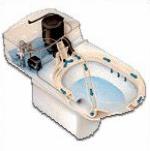Search engine visitors - click here to access entire "$ensible Home" web site
Click here to see a descriptive illustration of how several low-flush toilets work.
Dear Jim: Our old toilet looks bad. I would like a new stylish one that saves water, but I read the new ones do not flush effectively. What type of efficient toilet saves the most water but still flushes well? - Pam G.

A: There are toilet designs available that use no water or just a pint per flush, but you are probably looking for a more traditional toilet design. By law, all toilets sold today cannot use more than 1.6 gallons of water per flush (gpf). Your old one probably uses five gallons or more.
The dollar savings on your water bills, not to mention the environmental benefits, from installing a new low-water-usage toilet can pay back its cost in several years. People don't realize how often toilets are flushed. Toilets can be the greatest water consumer in a typical home.
Your old toilet uses a gravity flushing method. When you flush it, the water flowing down from the tank, not though the bowl, creates a suction to draw liquids and solids out of the bowl and down the drain. This worked great with five gallons, but is not always effective with only 1.6 gallons.
Although most reasonably priced toilets still use the gravity method, and some flush satisfactorily, there are other more effective flush methods. These often do not cost much more to buy and look like regular toilets.
Pressure-assisted toilets use the normal water pressure to flush better. There is a small tank within the standard tank. When this fills with water, it compresses the air inside. When flushed, the water flow is more forceful. They flush fast, but are slightly nosier than a standard toilet.
Another somewhat similar, traditional-looking toilet design uses a vacuum assist. When flushed, the water rushes out of the tank and creates a vacuum. This lower-pressure area is connected with passages inside the toilet to the water flow path. It increases the sucking action in the bowl.
If you are looking for major water savings or are planning to use a toilet in cabin with limited water availability, there are several effective designs. There are electric incinerating toilets that literally burn up the wastes. These don't create odors and only a small amount of sanitized ash is left.
Another design is a composting toilet that uses zero to a pint of water. Through a natural composting process, wastes become soil and fertilizer. Some models resemble an ordinary toilet and several toilets can be connected to one composting receptacle. With venting, there are no odors.
For convenience with children, consider an automatic flushing toilet. Powered two D-size batteries, it flushes when the toilet seat is closed.
Instant Download Update Bulletin No. 631 - buyer's guide of 13 new, low water usage toilets, types, shapes (round front, elongated bowl) styles (one- or two-piece), water usage (gallons per flush), colors, features, water/sewage savings chart, description of the types of toilets (composting, compressed air-assisted, gravity-flush, incinerating, liquefier, pressure-assisted, pump-assisted or vacuum-assisted), many illustrations of various types.
Dear Jim: I need to install some lights in my garage and I want to use efficient fluorescent lights. My neighbor has some, but they flicker in the cold weather. Are his lights faulty or will that happen to mine too? - Russ J.
A: The standard four-foot-long fluorescent tubes you buy for a dollar or so at hardware stores do not operate well in cold temperatures. They will flicker and may not even start at all when they get too cold.
For a garage that is unheated, choose high-intensity fluorescent fixtures and tube designed for outdoor use. They will operate better in the cold temperatures and still function well in normal and warmer temperatures.